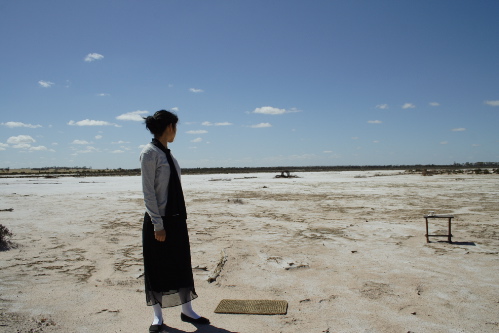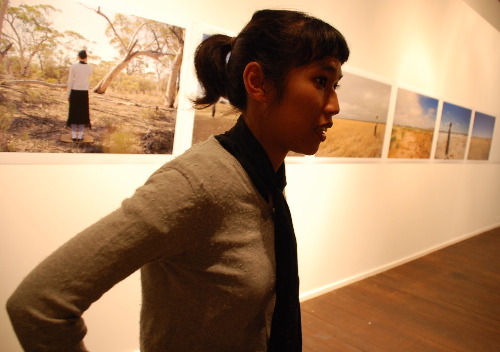I wrote the following article in response to seeing a series of photos by my Indonesian friend Pila.
The title of the above photo (which is available for sale I believe) is ‘act 05 of Hello And Goodbye series’
size: 60x100cm
2007
A neat, Asian girl is standing on the flat and dry expanse of the Western Australian wheat belt. Her clothes are contained and respectful. The nape of her neck, the intimate place only a lover would kiss, is all you can see of her skin as she turns to face the silver desolation of a salt lake. The land does not embrace her. It gives no gentle reciprocity to the newcomer. The sun light scours the horizon, showing no relief or refuge. The land has not received human love here, and it stares back at the visitor from under a layer of white scum. The anonymity of the earth’s face carries menace. The salty expanse holds no cherished niche or well known outlook. The only human stories to have past by here were those sealed behind the door of a moving ute. Once this land was briefly wheat for dollars. Now it is only erasure.
The girl cannot feel at home here. She comes from a land just across the narrow sea to the north. Seen from outer space the verdant greens of Indonesia’s mountains and islands create a vivid contrast with the ochre to scarlet reds of Western Australia. Now she stands here on the land down under and sees the flat line of the horizon. Before this moment lines meant only the vertical shapes of rising mahogany and teak. Now the line that rings the sky has been stripped of mountains and forests and is there before her.
Her name is Prilla Tania, or Pila for short. I visited her in the small farming town of Kellerberrin in south-western Australia, a few hundred kms from the coast, one Friday afternoon in dry December. I was there for the opening of an exhibition of photographs she had taken. In a series of six very large colour prints, the photos show her entering the hurt landscape and trying to feel at home. She steps over a doormat which sits at the bottom of each of the frames, picks up an English tea cup and drinks, standing in the living room of big sky and brown wheat. Her photos are a cycle that witness the degradation of the land. They start with the image of her stepping over the threshold into the original woodland of the area. Soon she is standing in a razed field, then in a field of wheat, and then, in one of her most powerful images, she is turning to confront the white plain of a salt lake. The inadequate tea cup of British settlement comes up again and again.
As I had made the three hour drive out into the area from the port city of Fremantle I had felt my mood sink a little. My eyes had searched for the biological wonders of diverse plant and animal life that have evolved to fit this arid corner of the planet, and come up with only horizon after horizon of ‘productive’ brown fields and the odd apologetic copse of trees. Now I had seen Pila’s photos I felt even more acutely the lack of welcome that this part of Australia held out to the visitor.
Even if white folk hadn’t knocked down the open woodland of this low rainfall country to make way for crops and sheep, the land still wouldn’t have been an easy one for most humans to embrace. This place was never lush or soft like the island of Britain or the rainforests of Pila’s home to the north. However in the past a fierce sun would have shone down on the lopsided antics of little Thorny Devils, the dark feathered flight of Black Cockatoos, the freckled trunks of Powderbark Wandoos, and the symmetrical crowns of gorgeous Salmon Gums. Now, with the clearing of millions of hectares of trees for agriculture the deep roots of the trees that kept the water table low have been replaced by the shallow roots of annual crops. The water table has risen, and millions of tons of salt in the soil has come to the surface, killing most things in its wake. With rising temperatures the future of this part of the world is looking even more squeezed.
After the exhibition was over we went back to the room next door to the gallery where Pila was staying. Me and another friend who had come along for the journey wanted to see some stars now that we were out of the city, so we walked down one of the few streets in the town. In two minutes we had left the lights of the suburban looking houses behind us and come to an old, wire fence. Beyond the fence lay a field. We climbed the old wire fence and walked forward into the night, hearing the crackle of our feet in the dry stubble. Darkness muffled the edge between the bright pattern of the milky way above and the emptiness of the field stretching out under our feet. Dark night and a cool wind blowing through the stubble of the wheat made me relax.
We paused and stood in silence. I squatted down and felt the blanket of rural darkness cover me. It was a comfort, and for the moment I felt an intimacy with this place. The endless blanks drawn by the sun were replaced with the smudged shapes of shadow and dark suggestion.
Now only night can bandage the wound.

